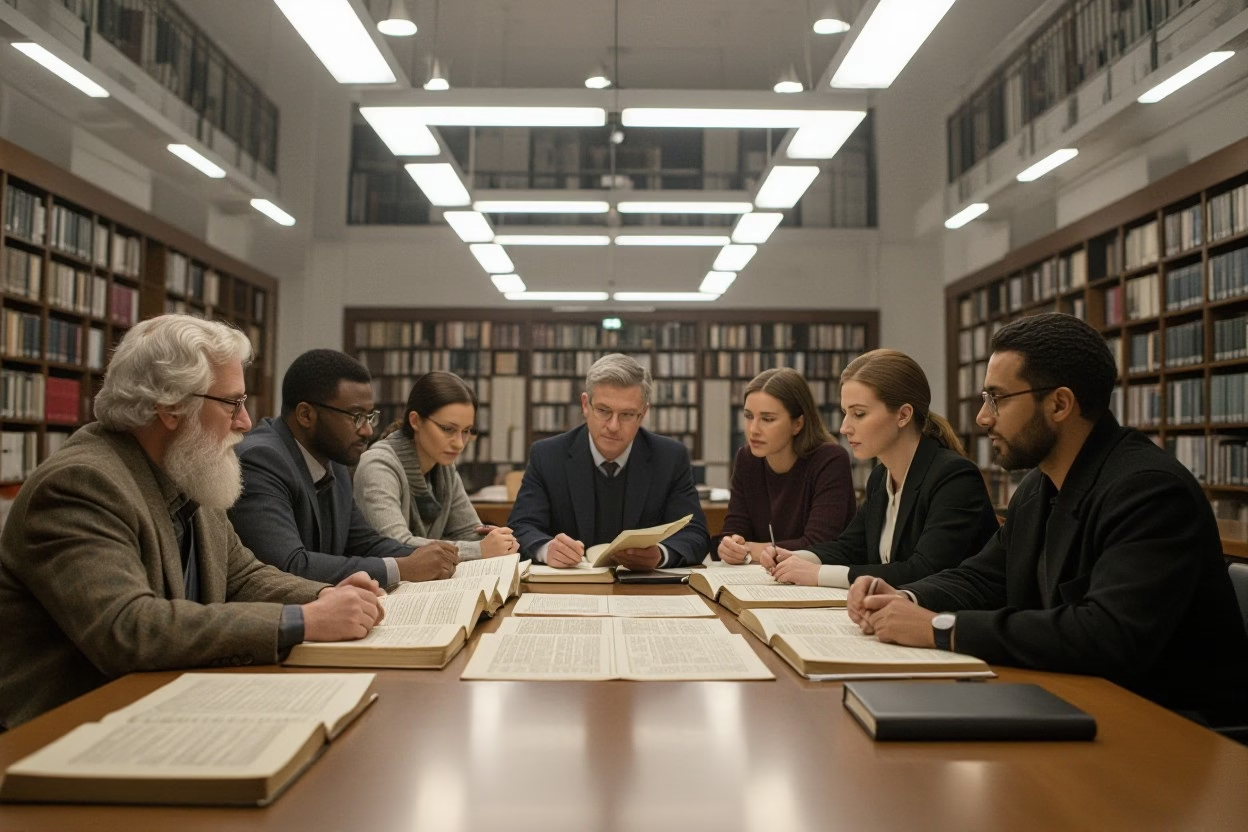Many believers encounter challenging Scripture passages that require more than casual reading. To interpret these texts accurately, they must employ practical study tools and sound interpretive methods. By using resources such as multiple translations, concordances, and trusted commentaries, he or she can avoid misunderstandings and derive faithful insights. This guide provides necessary strategies to help readers engage with difficult biblical texts thoughtfully and responsibly, fostering deeper comprehension and confident application.

Key Takeaways:
- Using multiple Bible translations helps reveal nuances and deepens understanding of passages.
- Concordances and word studies enable exploration of original Hebrew and Greek meanings of key terms.
- Verse mapping encourages careful analysis through writing, keyword study, and contextual connections.
- Cross-references support interpreting Scripture by comparing related verses on similar themes.
- Trusted commentaries and study guides provide valuable historical, cultural, and theological insights.
- Interpreting passages within their immediate and broader context prevents misinterpretation.
- Applying interpretive methods like historical-grammatical and literary analysis helps clarify author intent and thematic elements.
Unlocking Scriptural Meanings: The Power of Multiple Translations
The Importance of Translation Diversity
Different Bible translations reflect varying translation philosophies, from formal equivalence (word-for-word) to dynamic equivalence (thought-for-thought). Comparing passages across these types reveals subtle distinctions in meaning. For instance, examining John 1:1 in the New International Version (NIV) alongside the English Standard Version (ESV) and the New American Standard Bible (NASB) exposes nuanced renderings of “the Word” and “was God,” enhancing understanding of theological implications. This diversity helps avoid overreliance on a single linguistic or doctrinal framework and enables deeper engagement with Scripture’s original message.
Translators must make choices influenced by ancient languages, manuscript variations, and theological traditions. These decisions can affect how concepts such as covenant, salvation, or holiness are expressed. By consulting multiple versions, believers detect textual ambiguities and explore interpretive possibilities that might otherwise remain hidden. This approach guards against personal biases or doctrinal presuppositions coloring interpretation and encourages critical thinking alongside reverence for the biblical text.
Tools and Resources for Side-by-Side Comparisons
Modern technology provides convenient platforms to compare Bible translations simultaneously. Websites like Bible Gateway and Blue Letter Bible offer interactive parallel reading interfaces, permitting side-by-side analysis of dozens of versions. These tools often include features that highlight differences in vocabulary, sentence structure, and footnotes explaining variant readings or scholarly insights. Mobile apps such as YouVersion also enable offline comparison, allowing users to carry extensive translation libraries on their devices.
Study Bibles and printed parallel texts remain valuable for in-depth research, especially those that align multiple English versions with interlinear Hebrew or Greek. Combining these with digital concordances and lexicons strengthens the ability to see how particular words or phrases are rendered across translation traditions. Access to commentaries that reference multiple versions further contextualizes differences and clarifies difficult passages in light of historical and linguistic scholarship.
Comparison of Popular Bible Translation Tools
| Tool/Resource | Key Features |
|---|---|
| Bible Gateway | Over 200 translations, parallel reading mode, keyword search, verse-by-verse comparison, audio Bibles |
| Blue Letter Bible | Interlinear Scriptures, original language tools, commentaries integration, side-by-side translations |
| YouVersion App | Mobile access, multiple translations, offline reading, personalized notes, verse highlighting |
| Parallel Printed Bibles | Physical side-by-side texts, interlinear columns, notes on variant translations and manuscript evidence |
| Study Bibles with Translation Comparisons | Historical background, theological commentary, variant word study notes, contextual maps |
Believers who integrate multiple translation resources engage Scripture with broader linguistic and theological perspectives. By examining various renderings through these tools, they uncover hidden layers of meaning and develop a more balanced approach to biblical interpretation. These resources, paired with prayerful reflection, enhance clarity and guard against simplistic or erroneous conclusions.

Discovering Depth: The Role of Concordances and Word Studies
Utilizing Strong’s Concordance and Interlinear Bibles
Strong’s Concordance remains one of the most widely used tools for exploring the original meanings behind English Bible words. Each entry links an English term to its corresponding Hebrew or Greek root, identified by a unique number, allowing a student to trace how frequently and in what contexts a word appears throughout Scripture. For example, examining the Hebrew root hesed (Strong’s H2617) enriches understanding beyond a simple translation like “lovingkindness,” revealing its nuance of covenantal loyalty and steadfast love. This detail often gets lost in surface-level reading but comes alive through concordance study.
Interlinear Bibles complement concordances by displaying the original language text directly beneath the English translation. This side-by-side format grants immediate access to morphological information—such as verb tense, case, and voice—that influences how a passage should be interpreted. When working through a difficult verse, seeing the Greek word agape (ἀγάπη) aligned with its English counterpart, for instance, highlights the unique nature of the love described, differentiating it from other Greek terms like philia or eros. Together, Strong’s Concordance and interlinear Bibles provide a transparent window into Scripture’s linguistic layers, sharpening theological insight.
Key Processes for Effective Word Studies
A methodical approach to word studies begins with isolating one significant term from the passage, preferably one that shapes the theological or narrative thrust. Then, examining all its occurrences throughout the Bible helps to identify consistent themes or shifts in meaning over time and across authors. Cross-referencing these varying contexts often unveils a fuller picture of the concept or principle at the heart of that word.
Following textual investigation, critical assessment of the root word’s semantic range is necessary. This involves consulting lexicons and specialized dictionaries that categorize meanings by usage and historical development. For instance, the Greek word pistis commonly translates as “faith,” but a closer lexical study exposes layers such as trust, belief, and faithfulness, each with different implications depending on context. Researchers who document these nuances alongside relevant cultural and literary factors find their interpretations both richer and more precise.
Word studies gain further strength by integrating findings with broader biblical theology and typology. Careful synthesis of definitions, frequency of use, and canonical connections guards against isolated or distorted interpretations, ensuring that conclusions harmonize with the Bible’s unified message. This multi-dimensional process equips believers to encounter Scripture not just as ancient text, but as a living narrative woven with profound semantic textures.
Mapping Verses: Practical Approaches to Verse Mapping
Techniques for Identifying Key Concepts and Themes
Verse mapping begins with isolating the most significant words and phrases that shape a passage’s meaning. Underlining or circling repeated terms, commands, or descriptive adjectives highlights the author’s emphasis. For instance, in Romans 12:2, focusing on words like “transform” and “renewing” uncovers the theme of spiritual change rooted in God’s will. Comparing these terms across translations often reveals subtle variations—such as “renewing” versus “making new”—which deepen the understanding of the transformation process described.
After identifying key words, tracing their occurrences elsewhere in Scripture can expose broader theological themes. Mapping the concept of “renewal” alongside verses like Ephesians 4:23 and Titus 3:5 demonstrates a consistent biblical motif of inner spiritual regeneration. Grouping these insights visually, through charts or notes, assists in recognizing how specific ideas weave into the larger canonical narrative. This also enables a thematic mapping of related doctrines, such as sanctification or obedience, which might otherwise remain hidden in isolated verse study.
Integrating Historical and Theological Context
Placing a verse within its first-century cultural and historical setting sharpens the clarity of its message. For example, understanding the role of Greco-Roman societal norms explains certain metaphors or idioms unfamiliar to modern readers. In 1 Corinthians 9:22, Paul’s adaptive ministry approach gains fuller meaning when considered against the backdrop of diverse ethnic groups and social classes in the early church. Historical context reveals why certain distinctions mattered deeply for the original audience and how they inform theological interpretation today.
Theological context connects the passage to overarching biblical doctrines and church tradition. Exploring how a verse fits into themes like covenant, law and grace, or Christology reveals layers of meaning beyond the immediate text. For instance, studying Old Testament covenant promises alongside New Testament fulfillment passages enriches the understanding of God’s faithfulness. Consulting scholarly commentaries and creedal summaries can illuminate how theologians across history have interpreted and applied the verse, guiding a responsible reading within the church’s collective witness.
Historical and theological integration requires attention to both external factors—social environment, authorial intent, original audience—and internal factors such as genre, literary devices, and canonical relationships. Using tools such as Bible dictionaries, background commentaries, and theological lexicons enhances this process. The combined perspective guards against anachronistic interpretations and encourages alignment with the broader scriptural message, thus fostering a trustworthy application of Scripture.
Context is Key: The Art of Contextual Reading
Techniques for Reading Surrounding Verses
Examining the verses immediately before and after a challenging passage often unveils the author’s intended flow and argument. For example, understanding a single proverb within its chapter can expose thematic development or contrast that clarifies its message. Careful attention to paragraph breaks, shifts in tone, and transitional words guides interpreters in identifying whether a verse serves as a conclusion, an example, or a contrast within a larger discourse. Incorporating multiple translations here can also highlight subtle differences in how linking words or phrases are rendered, which impact overall interpretation.
The wider chapter or book context further grounds verses within historical or theological narratives. For instance, Paul’s statements in Romans become more precise when read alongside earlier theological explanations in the same letter. Verse mapping—writing out surrounding verses and noting repeated key terms or phrases—helps uncover connections that otherwise go unnoticed. Contextual reading also benefits from consulting cross-references that parallel or expand on themes, offering a web of scriptural insight rather than isolated proof-texts.
Avoiding Common Pitfalls of Isolation
Taking verses out of their narrative, literary, or doctrinal context can lead to distortions and misconceptions. A well-known illustration is the temptation to isolate Philippians 4:13 (“I can do all things through Christ who strengthens me”) and apply it universally without recognizing Paul’s specific context of contentment amid hardship. Isolating such verses risks turning nuanced teaching into oversimplified slogans, sometimes exploited in popular culture or motivational settings far removed from biblical intent.
Reductionist readings may also neglect key background factors such as the original audience’s culture, the author’s purpose, or the passage’s genre—elements that shape meaning profoundly. For example, prophetic or apocalyptic texts often employ symbolism and require interpretive frameworks informed by historical context and literary conventions. Ignoring these invites surface-level comprehension that misses important theological insights. Consulting study notes and commentaries can safeguard against these common errors by highlighting necessary contextual elements.
Isolation amplifies risks of misunderstanding by truncating Scripture’s rich, interconnected message. A verse seldom stands alone in meaning; rather, its depth unfolds through relationship with surrounding text, the broader biblical canon, and historic church interpretation. Consistently integrating these layers helps filter out partial or skewed readings, fostering interpretation faithful both to the Word’s integrity and its transformative application.
Scripture Illuminated: Using Cross-References to Enhance Understanding
Identifying Thematic Links Across the Bible
Cross-references reveal a rich tapestry of interconnected themes woven throughout Scripture, allowing readers to trace how specific concepts develop over time and in varying contexts. For example, exploring passages related to “covenant”—such as Genesis 15, Jeremiah 31, and Hebrews 8—illustrates God’s evolving relationship with His people. By assembling these threads, believers gain a more holistic view that situates difficult texts within the broader biblical narrative. This method highlights patterns like prophecy and fulfillment, justice and mercy, or the character of Christ, enhancing comprehension beyond isolated verses.
Noticing recurring motifs also supports theological reflection founded on Scripture’s unity. When a concept like “holiness” appears in Leviticus, Psalms, and 1 Peter, cross-references invite careful comparison of how holiness is expressed and lived out across different genres and covenants. This cross-pollination of ideas mitigates misinterpretations that arise from reading passages in isolation. Thematic linking leverages the Bible’s self-authenticating principle, which encourages interpreting difficult passages through the lens of clearer, related texts.
Tools for Efficiently Navigating Cross-References
Modern Bible study resources streamline the process of locating and utilizing cross-references, saving valuable time and sharpening insight. Software platforms like Logos Bible Software and Accordance offer synchronized cross-reference linking within their digital libraries, enabling users to instantly jump to related verses and compare parallel passages side by side. Similarly, online tools such as BibleGateway and Blue Letter Bible provide hyperlinked references that open exhaustive lists of related texts sorted by theme or keyword, facilitating targeted exploration.
Study Bibles remain an accessible resource with embedded cross-references in footnotes or marginal notes, making relevant connections visible as one reads. In addition, printed concordances and topical indexes—once standard in serious study—function as time-tested guides for identifying verses on particular themes, assisting in deeper word studies complementing cross-referencing work. The combination of these tools encourages believers to move beyond surface-level reading toward integrated, contextualized interpretation.
Utilizing technology alongside traditional print resources maximizes the efficiency and depth of cross-reference study. Digital platforms also offer search filters by original language, frequency, or canonical order, granting nuanced control over results. These features enable scholars and lay readers alike to uncover complex intertextual relationships, maintain focus on authorial intent, and systematically build a thorough biblical understanding rooted in Scripture’s interconnected nature.

Engaging with Experts: The Value of Commentaries and Study Guides
Recommended Commentaries for Various Texts
Commentaries often specialize by biblical genre or emphasis, making it effective to select resources tailored to specific portions of Scripture. For the Old Testament, the Anchor Yale Bible Commentary series offers in-depth historical and linguistic analysis, while the Word Biblical Commentary excels at technical exegesis suitable for deeper study. For New Testament texts, the New International Greek Testament Commentary (NIGTC) provides rigorous examination of Greek manuscripts and grammar, which is valuable for understanding nuance in the original language. Meanwhile, the IVP New Testament Commentary Series balances scholarly insight with accessibility, ideal for pastors and lay readers alike.
Study Bibles such as the ESV Study Bible and the NIV Cultural Backgrounds Study Bible complement commentaries by offering concise notes, maps, and overviews that highlight theological themes and ancient contexts. Their contributions are particularly helpful for connecting isolated passages to the broader biblical narrative. Integrating these resources allows readers to gain both detailed analysis and synthesized perspectives, fostering a well-rounded understanding of complex texts.
Distinguishing Between Scholarly and Devotional Resources
Scholarly commentaries prioritize historical context, original languages, and critical methodologies. Authors typically hold advanced academic credentials and engage with contemporary research, archaeological findings, and theological debates. These works include extensive bibliographies, critical footnotes, and often address multiple interpretive possibilities. They serve as indispensable tools for those aiming to uncover an author’s original intent and grasp nuances lost in translation or cultural distance.
Devotional resources, on the other hand, emphasize application and spiritual edification. These works tend to focus on how a passage encourages faith, holiness, or practical living, often reflecting a particular denominational or theological tradition. They avoid technical jargon and may incorporate personal stories, meditative questions, or sermons. While less critical in approach, devotional commentaries nurture heart-level engagement with Scripture and complement scholarly study by fostering spiritual growth.
Careful discernment is necessary when selecting resources so that a balanced approach emerges: one that honors the Bible’s original meaning without neglecting its life-transforming power. Scholars and lay readers alike benefit from consulting both types, coordinating the strengths of each to avoid either overly academic detachment or simplistic interpretation.
Reflective Reading: The Practice of Restating and Further Reflection
Techniques for Paraphrasing Scripture Effectively
Paraphrasing Scripture involves more than simply rewriting verses in one’s own words; it requires capturing both the explicit meaning and underlying intent of the passage. One effective technique is to begin with a thorough comparison of multiple translations to identify core ideas and phrasing variations. This step can reveal differences in emphasis or nuance that inform the paraphrase. Next, isolating key terms and consulting word studies on their original Hebrew or Greek roots ensures that the restatement maintains theological accuracy and avoids oversimplification.
Another method uses verse mapping as a framework: after writing out the verse, the reader circles significant words and phrases, then consults cross-references to related passages. Integrating these references into the paraphrase allows for a coherent summary that reflects broader biblical themes. This layered approach respects the historical and literary context, helping the reader produce a paraphrase that both clarifies and preserves the richness of the original text.
The Benefits of Personal Reflection in Understanding
Restating Scripture in one’s own words naturally leads to deeper engagement and critical thinking. As individuals wrestle with the passage’s meaning, they uncover areas of uncertainty or new insights that might be missed in passive reading. This reflective process encourages active participation, fostering better retention and comprehension. Moreover, personal reflection opens the door to applying the text’s message to present-day challenges and circumstances, moving interpretation beyond intellectual exercise into lived transformation.
Reflection cultivates humility and a posture of learning, enabling the believer to acknowledge gaps in understanding while seeking clarity through prayer and additional study. This internal dialogue often reveals how Scripture resonates uniquely with each reader’s spiritual journey, reinforcing the dynamic nature of biblical interpretation. Over time, reflective reading becomes a habit that sharpens discernment, enabling more nuanced application of complex passages.
In the broader scope of biblical study, personal reflection bridges the gap between academic tools and real-life faith, allowing believers to internalize Scripture’s message in a way that is both intellectually informed and spiritually meaningful. This practice supports a lifelong commitment to interpret Scripture faithfully and contextually, guiding responsible application amid changing contexts and challenges.
Merging Methods: Key Interpretive Approaches for Application
Historical-Grammatical vs. Literary Analysis
The Historical-Grammatical method zeroes in on the original context of the passage, analyzing its grammar, syntax, and the historical setting that shaped its content. This approach helps readers anchor Scripture in the author’s original intent, avoiding anachronistic or culturally detached interpretations. For example, understanding the nuances of Koine Greek verb tenses in Paul’s epistles can illuminate theological points that are otherwise lost in translation. Similarly, grasping the Jewish customs during Jesus’ ministry clarifies many parables and teachings that might seem obscure or confusing without historical background.
Literary Analysis adds a complementary dimension by focusing on genre, narrative structure, and symbolism within the biblical text. It reveals how the Bible’s diverse literary forms—whether poetry, prophecy, epistles, or apocalyptic literature—employ specific stylistic features to communicate their message. For instance, the book of Revelation’s rich symbolism requires sensitivity to its apocalyptic genre to interpret visions, numbers, and images correctly. Together, these methods equip the interpreter to consider both the original message and how it functions within the text’s broader literary framework.
Canonical Context and Thematic Exploration
Canonical Context examines the passage within the larger sweep of biblical revelation and the historic Christian witness. By situating a verse or passage within the entire canon, interpreters recognize patterns, doctrinal consistencies, and the progressive unfolding of theological themes. This approach highlights how the early church understood and applied the Scriptures, ensuring contemporary interpretation aligns with centuries of faithful tradition. For example, reading the concept of “covenant” in both Old and New Testament contexts reveals God’s unified plan of redemption through Christ, connecting key texts like Jeremiah 31 and Hebrews 8.
Thematic Exploration traces specific concepts or motifs across various books of the Bible, offering a holistic biblical perspective that avoids isolating passages. Following themes such as “kingdom of God,” “faith,” or “holiness” across Scripture uncovers their full theological significance. This method encourages cross-referencing between related texts, reinforcing Scripture’s internal consistency and enriching personal application. For instance, a thematic study on “mercy” might link the Psalms, prophetic writings, and Jesus’ parables, deepening insight into God’s character and expectations for believers.
Combining Canonical Context with Thematic Exploration moves beyond surface readings by weaving individual texts into the grand narrative of Scripture and historic theology. This fusion invites interpreters to appreciate both the continuity of God’s redemptive work and the diverse emphases found throughout biblical literature. Engaging with patristic writings, creeds, and confessions alongside Scripture increases interpretive depth and guards against modern misreadings detached from the church’s longstanding understanding.
Final Thoughts: Encouragement for Lifelong Interpretation of Scripture
The Journey of Continuous Discovery
Scripture, with its layered meanings and profound truths, invites believers into a lifelong journey rather than a quick destination. Even seasoned scholars consult multiple versions and commentaries to deepen their understanding. For example, renowned theologian F.F. Bruce often revisited difficult passages, demonstrating how persistent study expands insight over time. This ongoing process reflects the dynamic nature of God’s Word and the evolving spiritual growth of those who engage with it.
Embracing Humility and Openness
Encountering complex texts fosters a posture of humility. Many biblical interpreters, including Augustine and Calvin, exemplified openness to correction and new perspectives. Such humility guards against rigid interpretations that can lead to misapplication or doctrinal error. A believer who embraces the wealth of study tools—from interlinear Bibles exposing original Greek and Hebrew nuances to historical-cultural commentaries—cultivates discernment aligning closely with the authorial intent.
Integrating Tools with Prayer and Community
Reliance on study aids alone falls short without spiritual discernment and communal dialogue. Prayer sharpens the heart to perceive Scripture’s living message, while discussion with mentors and fellow believers unveils fresh angles and checks assumptions. Historical examples like the Bereans in Acts 17:11 illustrate the strength found in balancing diligent study with prayer and fellowship. This triad—tools, prayer, and community—forms a safeguard against both superficial readings and overly individualistic interpretations.
Application as the Goal of Interpretation
Ultimately, interpretation serves transformation. Insights gleaned through verse mapping, word studies, and cross-references become meaningful only when applied to life. Study notes and commentaries guide understanding, but reflection prompts believers to embody Scripture’s truths. For example, grappling seriously with passages on forgiveness using multiple translations and theological resources often fosters a tangible shift in personal relationships. This reflects the vital link between accurate interpretation and authentic Christian living.
Encouragement Amid Complexity
Believers tackling difficult passages should view challenges as opportunities for growth rather than discouragement. The history of biblical interpretation shows how persistent inquiry yields richness that nourishment faith and theology alike. As Martin Luther once noted, “The Bible is alive, it speaks to me; it has feet, it runs after me; it has hands, it lays hold of me.” This dynamic encounter continues as each generation employs trusted tools and methods, ensuring Scripture remains a vibrant source of wisdom.
FAQ
Q: Why is it helpful to compare multiple Bible translations when studying complex passages?
A: Comparing various translations reveals different ways translators have rendered original words and phrases, highlighting nuances and alternative expressions. This broadens understanding by showing how language, context, and theology influence translation choices, which can clarify difficult or ambiguous meanings.
Q: How do concordances and word studies assist in interpreting challenging Scriptures?
A: Concordances allow you to locate every instance of a particular word throughout the Bible, while word studies explore the original Hebrew or Greek meanings and root words. This helps uncover the depth behind key terms, showing how they are used in different contexts to enhance interpretation.
Q: What is the benefit of using cross-references during Bible study?
A: Cross-references link related passages that discuss similar themes or ideas. By studying these interconnected verses, you interpret Scripture with Scripture, which helps build a more comprehensive and consistent understanding of biblical concepts.
Q: How does verse mapping contribute to understanding difficult Bible texts?
A: Verse mapping involves writing out the verse, comparing translations, identifying key words, and exploring their meanings and contexts. This method encourages detailed examination and personal engagement, leading to clearer insight and greater retention of the passage’s message.
Q: What are the advantages of consulting trusted commentaries and study guides?
A: Commentaries and study guides provide expert analysis, historical background, cultural information, and theological insights that enrich your interpretation. These resources help illuminate complex ideas that may not be immediately evident from the text alone and offer perspectives grounded in scholarship.
Q: Why is it important to consider the historical-grammatical method in Bible interpretation?
A: The historical-grammatical method focuses on understanding the original language, grammar, and historical context in which the text was written. This approach helps anchor the meaning in the author’s original intent, reducing the risk of applying modern assumptions inaccurately to the passage.
Q: How can restating a Bible passage in your own words aid comprehension?
A: Restating encourages active engagement and forces you to process the meaning carefully. This practice brings clarity to what is understood and highlights areas needing further study, thereby deepening comprehension and allowing for practical application of the Scripture.





